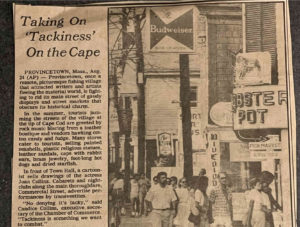PROVINCETOWN — Eight LGBTQ business owners pooled their money in 1978 and started marketing Provincetown to gay tourists. They spent less than $1,000 on ads in New York theater magazines and national gay circulars like Blue Boy and After Dark, but that small step was the start of what would become the Provincetown Business Guild.
The Provincetown Chamber of Commerce traces its roots to 1897, when the Board of Trade was founded; it advocates for business interests of all kinds, according to Chamber president Patrick Patrick.
The two groups get along now — but they didn’t always.
“This is one of the easiest ways to explain why there’s the PBG and the Chamber,” Stephan Hengst, the new executive director of the PBG told the Independent when he started the job in February.
He produced a yellowed newspaper clipping from the New York Times, Aug. 24, 1984. It is an Associated Press story with the headline “Taking On ‘Tackiness’ on the Cape.”
“Provincetown, once a remote, picturesque fishing village that attracted writers and artists fleeing the material world, is fighting to rid its main street of gaudy displays and street markets that obscure its historical charm,” the piece begins.

It’s not just plastic tchotchkes that were unwanted, though. “Cabarets and nightclubs along the main thoroughfare, Commercial Street, advertise performances by transvestites,” the article says.
“No denying it’s tacky,” Candice Collins-Bowden, then executive secretary of the Chamber of Commerce, said in the piece’s next sentence. “Tackiness is something we want to combat.”
Collins-Bowden ran the Chamber for four decades, until current executive director Radu Luca took over in 2019. Now retired but still living in Truro, Collins-Bowden called the rift between her group and the PBG as outdated as the careless homophobia espoused by the New York Times itself in 1984.
It is true, she admitted, that some business owners were angry at first that a group would exclusively promote the town as a gay destination.
Not long after that article, however, the two groups began to see that they had different perspectives but one ultimate goal — to attract people to Provincetown.

The thaw began in 1986, said Collins-Bowden, when she started the lighting of the Pilgrim Monument during the holidays. Gene Green, a restaurant owner, was the PBG president at the time, and they were good friends, Collins-Bowden said. During the monument lighting ceremony, the PBG organized candle lighting and distributed hot cider, she said. Green later died of AIDS.
Paul Niedzwiecki, the CEO of the Cape Cod Chamber of Commerce, said it is not unusual for a town to have more than one business or tourism group. Hyannis has three.
According to Bob Sanborn, the recently retired director of the PBG, most businesses are members of both organizations. Sanborn estimates that between 60 and 80 percent of Guild members are also Chamber members. Luca said between 70 and 80 percent of Chamber members belong to the PBG.
LGBTQ tourists now make up 66 percent of Provincetown’s visitors, according to a 2018 survey conducted by the town. They are everyone’s customers.
Paul Melanson and Jack Kelly, who co-own Tin Pan Alley and Post Office Café, happily belong to both groups “because they target different audiences and have different benefits,” Melanson said. “The PBG specifically targets gay tourists, and as a gay-owned business, that’s important to us. The Provincetown Chamber promotes to all tourists and is especially effective with day-trippers.”



